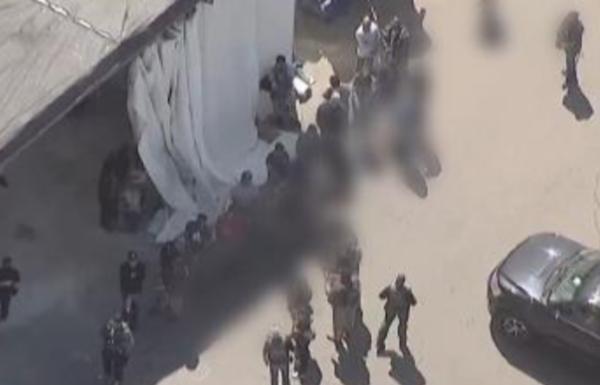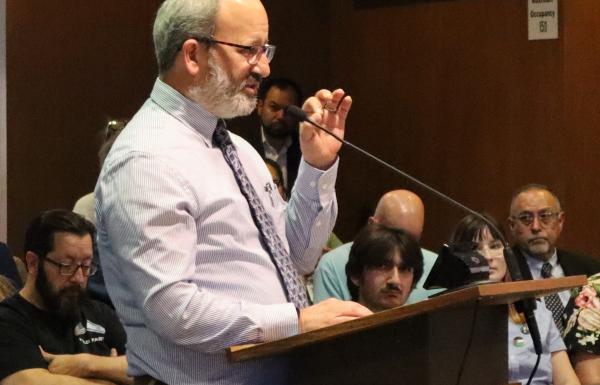Features, Food & More
Latest articles
DARK SIDE: TRUE STORIES FROM A TEENAGE POT SMUGGLER

Memoir by Stu Stall
Reviewed by Pennell Paugh
April 1, 2025 (San Diego) -- Stu Stall, a life-long resident of Coronado, has released a second memoir -- Dark Side: True Stories from a Teenage Pot Smuggler.
The book is filled with tales of adventure, danger and betrayal. Stall’s life in his twenties seemed carefree — full of parties, women, surfing and marijuana highs. When he expanded his drug trafficking terrain, he exposed himself to greater danger, coercion, manipulation and schmoozing. He ends up being lucky to get out of the business.
Though Stall is caught and has several periods in court, he manages to get off without any jail time. However, he sadly recalls many of his friends were ground up by the War on Drugs and by heroin and cocaine addiction. He ends the book with the controversial conclusion that the War of Drugs seems more harmful than making drugs legal and providing treatment.
To show the author’s easy writing style, here is an excerpt from the book:
“It had been a great morning. The surf was perfect. Now, I was resting before work began. I’d been working as a waiter and maître d’ at Chez, a French restaurant, while attending college. Just then the phone rang. It was Judy Jordan, my dearest and most treasured friend from childhood. I would do anything for Judy. She was my favorite person since I was a kid. Sure, I had buddies at school and in sports, but when I was on my block, I was usually with Judy. Not only did I love her, but my sisters loved her and my mom loved her; she was part of the family.
“More than a big sister, Judy was my best friend. She taught me how to dance and so many other things about life too. Her dad dressed her in boy’s clothing and called her a tomboy, but she was super pretty. I don’t know if they were her brother’s old clothes (Navy guys were notoriously cheap) or if he was trying to protect her from the boys. All I know is he had to know how beautiful she was.
“As the years went on, we became slightly estranged, but our bond remained strong. Judy had a disastrous marriage when she was younger and ended up staying with me for a couple of months when she was down and out. She just showed up one day, and there was no way I could say no to her. I wouldn’t let her sleep with me, however, even though she wanted to (as I still thought of her more as a sister).
“I, Stuart Stall, did not let one of the most beautiful women I ever met in my life sleep with me. I still don’t know why. I guess I wanted to keep the status quo. But only a couple of years later, when I had a safe house in Cardiff, I acquiesced and had a night I will cherish for the rest of my existence.”
Stuart Stall obtained a finance degree from San Diego State. Before that he worked for many years as the maître d’ at Chez Loma. He raised two sons who graduated from Coronado High School (CHS) and is himself a class of ’72 graduate (his father was CHS class president in 1942). Stall is fond of saying he’s “a recovering mortgage and real estate broker.”
- Read more about DARK SIDE: TRUE STORIES FROM A TEENAGE POT SMUGGLER
- Log in or register to post comments
CA CLIMATE CREDIT TO OFFSET SDG&E CUSTOMERS' GAS & ELECTRIC BILLS BY AS MUCH AS $136 IN APRIL

Residential customers will receive the first two installments of bill credits this month; electric and gas-bill credits total more than $200 per household for 2025.
Source: SDG&E
March 31, 2025 (San Diego) - San Diego Gas & Electric® residential customers will get a break on their energy bill, thanks to the California Climate Credit administered by the California Public Utilities Commission as a result of the state’s effort to fight climate change. In April, residential electric customers and qualifying small businesses(link is external) will see a $81.38 credit on their statement. Residential customers with natural gas will also receive a $54.21 credit on the same statement.
This October, SDG&E residential customers who have electric service will see a second credit applied to their billing statement. The three credit installments total $217 in bill credits in 2025.
AUTHOR OF BOOK ON JOHN D. SPRECKELS SPEAKS IN LEMON GROVE APRIL 3

East County News Service
March 30, 2025 (Lemon Grove) – The Lemon Grove Historical Society’s “History Alive” lecture series continues this Thursday, April 3 at 7 p.m. with local author Sandra Bonura speaking about her new book, Empire Building: John D. Spreckels and the Making of San Diego.
The event will be held at the H. Lee House in Treganza Park, 3205 Olive St., Lemon Grove.
Sugar mogul, newspaper publisher and railroad baron, Spreckels was at the forefront of innovation and building San Diego. In the early 20th century, one in 15 San Diegans worked for a company owned by Spreckels.
LAMPLIGHTERS THEATRE PRESENTS BRIGHT STAR APRIL 18-MAY 18

East County News Service
March 30, 2025 (La Mesa) – Bright Star, a sweeping tale of love and redemption set against the rich backdrop of the Blue Ridge Mountains in the 1920s and ’40, takes stage at Lamplighters Theatre. The play opens April 18 and runs through May 19.
Bright Star is inspired by a real event and featuring the Tony and Grammy-nominated score by Steve Martin and Edie Brickell. When Alice Murphy, the brilliant editor of a southern literary journal, meets Billy Cane, a soldier just home from World War II, they discover a powerful secret that alters their lives. An uplifting theatrical journey that holds you tight in its grasp, Bright Star is as refreshingly genuine as it is daringly hopeful.
With its San Diego premiere at The Old Globe Theatre in 2014, Bright Star is written and composed by Steve Martin and Edie Brickell. The musical is inspired by their Grammy-winning collaboration on the 2013 bluegrass album Love Has Come for You and in turn, the true folk story of the Iron Mountain Baby.
DIRECTOR: Teri Brown
MUSIC DIRECTORS: Robert Johnson & Jerrica Stone
CHOREOGRAPHER: Sharla Mandere
ASSISTANT DIRECTOR: Abby Lacey
PRODUCERS: Cydney King & Nancy Roger
CAST: Anthony Donovan, Don Evans, Michael Harrison, Josalyn Johnson, Mitch Krassin, Marcy Ledvinka, Nikki Lyn Maas, Christopher T. Miller, Keri Miller, Lee Price, Hannah Roskelley, Matt Sayre, Odie Taylor and Car Thometz
PERFORMANCE DATES: April 18 through May 18, 2025:
Shows are Fridays and Saturdays at 7:30 p.m.
Sundays at 2:00 p.m.
Matinee Saturday April 26 at 2:00 p.m.
TICKETS: General admission: $30.00 Students/Seniors/Military: $27.00 (group rates available)
TICKETS MAY BE PURCHASED AT by calling the box office at 619-303-5092 and leaving a detailed message, or by emailing boxoffice@lamplighterslamesa.com.
Bright Star contains adult situations and language. This production is best suited for those over the age of 14 and is presented by special arrangement with Theatrical Rights Worldwide.
More information: https://www.lamplighterslamesa.com/
EGG PRICES STILL RISING RAPIDLY AMID AVIAN FLU OUTBREAKS; JUSTICE DEPT. LAUNCHES PRICE GOUGING INVESTIGATION

By G. A. McNeeley
Photo courtesy of Brian McNeeley
March 19, 2025 (Washington D.C.) — The Agriculture Department predicts egg prices could rise by more than 40%, on top of already steep price rises in 2024. While egg producers blame bird flu outbreaks, the Justice Department this month announced an investigation into whether egg producers might be sharing information and engaging in price gouging, ABC News reports.
President Donald Trump’s campaign platform including a pledge to bring down inflation including egg prices, but so far, prices continue to skyrocket. Now, the administration is offering its first details on its plan to fight avian flu and ease costs.
With an emphasis on farms tightening their measures to prevent avian flu’s spread, Agriculture Secretary Brooke Rollins says the US Department of Agriculture (USDA) will invest another $1 billion on top of the $2 billion it has already invested, since the outbreak first began in 2022, AP reports.
The main reason egg prices have climbed (hitting an all-time average high of $4.95 per dozen) is that more than 166 million birds have been slaughtered to limit the virus’ spread when cases are found. Most were egg-laying chickens. Just since the start of the year, more than 30 million egg layers have been killed.
However, new research by Food and Water Watch suggests that major egg corporations might also be using the avian flu as an excuse to raise the price of eggs, the Guardian reports.
The Price of Eggs Is Rising
The USDA is predicting that the cost of eggs will go up by 41.1% this year.
Prices have more than doubled since before the outbreak began, costing customers at least $1.4 billion last year, according to agricultural economists at the University of Arkansas. Some customers are even paying more than a dollar per egg (over $12 a dozen) in some places.
Rollins acknowledged that it will take some time before customers see an effect at the checkout counter. It takes infected farms months to dispose of deceased birds, sanitize their farms and raise new birds.
“It’s going to take a while to get through, I think in the next month or two, but hopefully by summer,” Rollins told AP News.
What Is The Administration’s Plan?
The plan calls for $500 million investment to help farmers bolster biosecurity measures, $400 million in additional aid for farmers whose flocks have been impacted by avian flu, and $100 million to research and potentially develop vaccines and therapeutics for U.S. chicken flocks, and explore rolling back what the administration sees as restrictive animal welfare rules in some states, such as California’s cage-free requirement, a humane animal treatment measure that was approved overwhelmingly by voters. However, increasing crowding by keeping poultry in cramped cages could actually increase spread of the disease.
The USDA has already paid farmers roughly $1.2 billion for the birds they had to slaughter, AP reports. The additional aid will continue going to those payments, and help farmers bring in new flocks more quickly.
The administration is in talks to import about 70-100 million eggs from abroad in the coming months, Rollins said. But there were 7.57 billion table eggs produced in the U.S. last month, so those imports don’t appear likely to make a significant difference in the market.
Trump administration officials have suggested that vaccines might help reduce the number of birds that have to be slaughtered when there is an outbreak. However, no vaccines have been fully approved for widespread use in poultry, and the industry has said the current prototypes aren’t practical because they require individual shots for each bird. Plus, vaccinated birds could jeopardize exports, since some countries have restrictions.
Fired Workers Are Being Rehired
Rollins said she believes the USDA has enough staff to respond to avian flu, even after all the cuts to the federal workforce at the direction of Elon Musk’s Department of Government Efficiency (DOGE).
“Will we have the resources needed to address the plan I just laid out? We are convinced that we will… as we realign and evaluate where USDA has been spending money, where our employees are spending their time,” Rollins told AP News.
Democratic U.S. Senator Amy Klobuchar said the new plan is an important step, but the USDA needs to confirm it rehired everyone involved in the avian flu response who was mistakenly fired.
“At a time when producers are already grappling with the bird flu, the public is facing high prices, and all Americans are on edge about what broader spread of this virus could mean, the last thing the administration should have done was to eliminate these positions,” Klobuchar told AP News. “USDA must rehire these crucial personnel immediately.”
The Agriculture Department is scrambling to rehire several workers who were involved in the government’s response to the ongoing avian flu outbreak that has devastated egg and poultry farms over the past three years.
A USDA spokesperson said the department “continues to prioritize the response to highly pathogenic avian influenza (HPAI)” and several key jobs like veterinarians, animal health technicians and other emergency response personnel involved in the effort were protected from the cuts. Some employees of the USDA’s Animal and Plant Health Inspection Service (APHIS) were also eliminated.
“Although several APHIS positions supporting HPAI were notified of their terminations over the weekend, we are working to swiftly rectify the situation and rescind those letters,” the department spokesperson told AP News.
Politico and NBC News reported that the jobs that were eliminated were part of an office that helps oversee the national network of labs the USDA relies on to confirm cases of avian flu and other animal diseases. It wasn’t immediately clear how many workers the department might be trying to rehire, or if any of them worked at the main USDA lab in Ames, Iowa.
Avian Flu Is Affecting Egg Production
Egg and poultry farmers have already been working to protect their birds by making workers change and shower before entering barns, using separate sets of tools, and sanitizing any vehicles that enter farms. The challenge is that wild birds easily spread the virus.
The department has already done biosecurity reviews on about 150 farms and only one had an outbreak afterward, the USDA said, so officials believe more can be done to protect birds and they are going to make those reviews available to more farms. Any farm that has an outbreak has to undergo a biosecurity audit, and the government will help pay up to 75% of the needed biosecurity improvements.
The vast majority of avian flu outbreaks have been on factory farms where hundreds of thousands (or sometimes millions) of egg-laying hens are caged in close proximity, creating ideal conditions for the rapid spread of infectious diseases.
If one hen is infected, federal regulations call for the entire flock at the affected site to be killed – due to the risks posed by the deadly and highly contagious virus to other poultry, animals and humans, further disrupting supply and increasing costs.
So far, 70 human cases have been confirmed in the US. One person has died and another three have required hospital treatment. Almost 1,000 cattle herds have been infected, and more than 54 million birds have been affected in the past three months. The virus has also been detected in almost every US territory.
Almost 631 million eggs were produced in January 2025 (nearly 10% fewer than January 2022, as flock sizes continue to drop). The USDA tracks pullets (the chicks hatched to replace egg-laying hens) which have been below the five-year average most months since the outbreak began in February 2022.
Corporations Are Also To Blame
While avian flu has been a principal driver of rising egg prices, the highly concentrated egg market may also be contributing, according to an analysis by Food and Water Watch (FWW).
“Bird flu does not fully explain the sticker shock consumers experience in the egg aisle… corporate consolidation is a key culprit behind egg price spikes,” Amanda Starbuck told The Guardian.
“Powerful corporations that control every step of the supply chain (from breeding hens to hatching eggs to processing and distributing eggs) are making windfall profits off this crisis, raising their prices above and beyond what is necessary to cover any rising costs,” Starbuck added.
The analysis found that in some regions, prices were going up even before the new strain of the deadly H5N1 virus had affected poultry flocks and reduced egg production. Even as egg production recovered in 2023, prices did not come down.
The country’s largest egg producer, Cal-Maine, boasted a sevenfold increase in gross profits in 2023, after increasing prices above rising costs despite its flocks not being affected by avian flu during that period.
Cal-Maine, which produces one in every five eggs eaten in the US, issued shareholder dividends totaling $250 million in 2023 – 40 times more than the previous year. The company sold 7% more eggs in 2024 (compared with 2021) and tripled its profits over the same period, according to company filings.
“The working class is struggling to afford groceries while companies like Cal-Maine are raking in huge profits and rewarding their shareholders,” Democratic congressman Ro Khanna told The Guardian. “The Trump administration has the power to lower grocery bills, but instead they are imposing blanket tariffs on allies, firing federal workers who are trying to prevent the bird flu, and putting billionaires over ordinary Americans.”
The top five egg companies own almost half (46%) of all egg-laying commercial hens. Headquartered in Mississippi, Cal-Maine is the only publicly traded US egg producer, and has 75% more hens than the next largest company.
In its financial documents, Cal-Maine suggests egg prices are outside the company’s control: “We do not sell eggs directly to consumers or set the prices at which eggs are sold to consumers.” But many of its customers rely on Cal-Maine for the majority of their egg needs, according to company filings, so the price it sells its eggs factors into grocery store prices.
Lakeside egg rancher speaks with ECM
East County Magazine spoke with Frank Hilliker, co-owner of Hilliker’s Ranch Fresh Eggs in Lakeside.
Hilliker said that while his business doesn’t have the avian flu, “it’s driven prices of eggs so high that a bunch of people don’t want to buy.”
Regarding the many chickens killed nationwide due to exposure to avian flu, Hilliker said, “When you take that kind of supply off the market,” it will heavily affect the production of eggs, as well as their prices.
Hilliker said bird flu has actually increased demand, forcing rationing of sales per customer. “We’ve always sold eggs at the farm, and we’re not selling any more eggs out of the farm now than before, but we have more customers.” He added that they also “put limits on what people can buy,” which make it so they’re, “able to spread it out a little bit more that way.”
The farm has capacity for 30,000 chickens, according to Hiilliker. As for steps being taken to prevent bird flu from infecting his flocks, Hillkier explained the farms’ health and safety protocols. “We’re locked down in our chicken areas. Everything that goes through the gates where the chickens are, is disinfected,” which includes people and equipment, he said.
Sources:
https://apnews.com/article/record-egg-prices-usda-bird-flu-virus-92e9f5fbc4e0a792be484a4aee5b9c16
https://apnews.com/article/usda-firings-doge-bird-flu-trump-fdd6495cbe44c96d471ae8c6cf4dd0a8
Wildfires
ARREST MADE FOR SUSPECTED ARSON IN PALA AND LILAC FIRES

Source: Cal Fire
March 2, 2025 (San Diego) – Cal Fire law enforcement investigators have arrested Ruben Vasquez on multiple felony arson charges following an extensive investigation into two wildland fires that ignited on January 21. The fires, known as the Pala Fire and the Lilac Fire, started 25 minutes apart near Interstate 15 and State Route 76 in the Pala Mesa and Bonsall areas.
Together, they burned nearly 100 acres and prompted evacuations affecting hundreds of residents. Witness reports and investigative efforts led to the identification of Vasquez as a suspect.
On February 28, Cal Fire Law Enforcement Investigators arrested Vasquez for two counts of felony arson, and he was transported to the Vista Detention Facility. The investigation report will be referred to the San Diego County District Attorney’s Office.
Cal Fire indicates that arson investigations are complex and require thorough evidence collection, scene examination, and witness interviews, which can be time-consuming. Accurate findings are essential for accountability and preventive measures.
Cal Fire extends gratitude to its partners at the San Diego County Sheriff's Office, North County Fire Protection District, U.S. Customs and Border Protection and the San Diego County District Attorney’s Office for their valuable support and assistance during the investigation.
SANTEE FUNDS TEMPORARY FIRE STATION, SETS NEW PLAN FOR TOWN CENTER

By Mike Allen
Photo: Santee Fire Department responding in 2023
March 1, 2025 (Santee) -- The chaos and disruption happening daily at the federal government isn’t permeating to the local level in Santee, where the City Council took several significant actions this week, including funding the remaining balance on a $2 million temporary fire station, adopting a new specific plan for its Town Center area, and hearing that its finances are in sterling shape.
The East County city of 60,000 has long acknowledged that it lacks adequate fire protection, making due with the same two fire stations that existed decades ago. At the prompting of the local firefighters’ union last November, the Council unanimously backed their plan to raise some $54 million through a half-cent sales tax increase and bond issuance to build two new stations, and hire additional staff.
Santee voters rejected the idea, forcing the Council to address the issue without imposing new taxes on the public.
The temporary station, which converted a maintenance operations yard to a fire station off Olive Lane, was approved in 2023, and is close to completion. Initially, the Council appropriated $1 million for the temporary station, but the final bill will be about twice that amount.
To finish the project, the Council allocated some $425,000 it still had left of federal stimulus funding to go with earlier allocations and transfers. The contract was awarded to Horizons Construction Co. of Orange, CA, the same one that did the living quarters building.
The slew of provisions contained in the vote gives Fire Chief Justin Matsushita the power to make change orders to a maximum of $151,000 or 15 percent of the contract, which will be done in a design-build mode.
The action triggered little comment from the five elected officials except from Councilman Rob McNelis who said he was under the impression the new financing arrangement would result in a surplus to the city. Matsushita said he didn’t recall stating that.
The new station will provide much better response times to calls emanating from the southern part of Santee, and relieve pressure on the city’s two aging stations, one on Carlton Oaks Drive, and the other on Cottonwood Avenue. The overwhelming number of calls are for medical emergencies. Of the total 919 calls the Santee Fire Dept responded to in January, 708 were medical related, and only 18 involved fire, according to numbers posted on the department’s Facebook page.
In other actions, the Council adopted a revised Town Center Specific Plan, setting a framework of planning concepts for the city’s core section, roughly bounded on the north by Mast Boulevard, on the south by Mission Gorge Road, on the east by Magnolia Avenue, and on the west just past Town Center Drive. Hired consultant Mark Steele said the vision that developed from several public workshops held in Santee was for “an American village” with five distinct neighborhoods anchored by an Arts and Entertainment neighborhood.
Mayor John Minto said adopting the new plan that replaces the first specific plan of 1986 is one more step in a process of transforming the city to having “communities and amenities that are just dynamic enough for people to want to be here.”
Santee has been trying to change its image in recent years as not just a convenient shopping destination, but for enjoying the benefits of a concentrated group of restaurants, art galleries, and live performing venues that would attract both residents and visitors, as well as generate more sales tax revenue through visitors’ spending.
For the most part, that effort has failed. A lynchpin project, a Karl Strauss brewery/restaurant/office complex along the San Diego River behind Trolley Square approved more than a decade ago, was downsized to a tasting room, and even that is still in limbo. A combined movie theater/restaurant project called Studio Movie Grill planned to go next to Karl Strauss didn’t happen when the company went bankrupt. And a 97-room hotel at Trolley Square that was approved in 2023 got mired in litigation, and hasn’t broken ground.
The city’s longstanding summer concert series at Town Center Community Park is successful in drawing folks, and the city continues to bring in new restaurants, but some venues that have shuttered several years ago such as Mimi’s remain closed.
At least the city’s financial condition remains well in the black. In a report on the soon to be completed 2024-25 fiscal year, Finance Director Heather Jennings said the city should end up with a balance on its general fund of $16.7 million from a budget of about $64 million at the end of June. That essentially is a net profit on its revenues after paying expenses and provides Santee with an envious reserve balance of 27 percent of the total, well above a target threshold on reserves of 22 percent.
Among the main contributors to the city’s heftier balance sheet are some $206,000 more in property taxes that was projected; about $235,000 more in sales taxes; and $436,000 more in interest income. It is also saving money from job vacancies not being filled to the tune of $1 million, Jennings said in her report.
Among the unexpected expenditures listed in the report but not commented upon was $61,470 for “materials and supplies related to a cyber incident.”
SENATOR PADILLA, COLLEAGUES PUSH TRUMP ADMINISTRATION TO EXEMPT SEASONAL FIREFIGHTERS FROM FEDERAL HIRING FREEZE

East County News Service
February 27, 2025 (Washington D.C.) -- U.S. Senator Alex Padilla (D-Calif.) joined 14 other Democratic Senators in urging senior Trump Administration officials to reverse the hiring and onboarding freeze of federal seasonal firefighters that they say threatens the safety of communities in California and across the nation. The Trump Administration’s January 20 hiring freeze of federal civilian employees inexplicably did not exempt federal seasonal firefighters, despite exempting other critical public safety personnel.
Federal seasonal firefighters risk their lives to protect communities and save lives. According to a press release issued by Padilla, "This hiring freeze is particularly dangerous as we ramp up staffing and training ahead of peak wildfire season.”
While Padilla secured a temporary pay raise for wildland firefighters in the Bipartisan Infrastructure Law, recruitment and retention remain significant challenges as firefighters work long hours with insufficient pay. The attrition rate of firefighters at the U.S. Forest Service (USFS) has been 45 percent over the past four years — making the hiring freeze at USFS, the Bureau of Land Management, and the National Park Service all the more dangerous.
“The Administration must not sacrifice the safety of the American people for the benefit of implementing a political agenda,” wrote the Senators. “We urge you to immediately reverse course, begin hiring and onboarding seasonal firefighters again, and continue supporting and growing the federal firefighting workforce. The bottom line is this: pausing the hiring and onboarding of federal seasonal firefighters — while historic wildfires destroy communities and upend livelihoods across the West — is simply irresponsible and dangerous. We will be woefully unprepared to fight the fires to come and instead will continue to see record levels of damage, ultimately costing communities and taxpayers even more at a time when the cost of living is already too high.”
Wildfires are increasing in frequency and destructiveness in California and across the nation. Last month, the devastating Southern California fires, including the Palisades and Eaton Fires, burned over 57,000 acres and destroyed over 16,200 structures, claiming the lives of at least 29 victims. Nationally, over 64,800 fires burned 9 million acres in 2024, up from approximately 56,500 wildfires and 3 million acres in 2023. The rise in catastrophic wildfires demands even more seasonal firefighter hiring — not a freeze.
In addition to Senators Padilla and Rosen, the letter was also signed by Senators Michael Bennet (D-Colo.), Catherine Cortez Masto (D-Nev.), Martin Heinrich (D-N.M.), John Hickenlooper (D-Colo.), Mark Kelly (D-Ariz.), Angus King (I-Maine), Ben Ray Luján (D-N.M.), Jeff Merkley (D-Ore.), Bernie Sanders (I-Vt.), Jeanne Shaheen (D-N.H.), Tina Smith (D-Minn.), Chris Van Hollen (D-Md.), and Ron Wyden (D-Ore.).
Senator Padilla has consistently pushed to protect our wildland firefighting force. Last month, Padilla reintroduced the bipartisan Wildland Firefighter Paycheck Protection Act to protect the pay raise he secured for wildland firefighters in the Bipartisan Infrastructure Law. In 2023, Padilla and a bipartisan group of Senators urged Senate leadership to avoid mass resignations within the wildland firefighter ranks by ensuring the prompt passage of their bipartisan legislation. Padilla and a bipartisan group of Senators also urged the Biden Administration to establish a special pay rate for federal wildland firefighters to prevent staffing shortages and strengthen wildfire response efforts in 2022. Following that request, the Biden Administration announced a temporary pay raise. Additionally, Padilla’s Wildfire Emergency Act, announced last week, would establish a prescribed fire-training center in the West and authorize grants to support training the next generation of foresters and firefighters, among other important fire mitigation efforts.
Full text of the letter is available here.
EL CAJON CITY COUNCIL’S FIRE DEPARTMENT COVERAGE WORKSHOP

By G. A. McNeeley
February 15, 2025 (El Cajon) - The El Cajon City Council, city staff, Heartland Fire Department and labor representatives came together on Wednesday to discuss possible short-term options, to staff a newly purchased fire engine, after a grant failed to fund.
Last year, the City Council explored options to augment fire and medical response coverage throughout the city. The Council directed staff to acquire an additional fire engine and seek a grant to fund the staff to operate that engine. Although the engine was acquired, the City was not successful in obtaining the grant. Their intent was to operate the engine (E-208) out of Station 8 as a full service vehicle, staffed with nine new employees. The grant would have paid for the majority of those employees.
On February 12, a workshop was held at the El Cajon City Council Chambers to discuss options that the City Council may wish to pursue in light of not receiving the grant. As part of its presentation, staff provided an update on data presented in 2024. The staff also presented short-term options for the City Council to consider.
Background Information
Staff reported that call volumes have been going up for the fire department in recent years.
For example, the fire department received 9,556 calls for response in 2003, 10,246 calls in 2008, 11,863 calls in 2013, 15,802 calls in 2018, 17,928 calls in 2023, and 17,574 calls in 2024.
Between 9:00 a.m. and 8:00 p.m. are the busiest hours for Heartland Fire Department in El Cajon.
El Cajon’s turnout time is an average of 2:00 minutes, with a total response average of 9:22 minutes. You can compare this to La Mesa and Lemon Grove, who have a turnout time with an average of 2:17 minutes and 2:05 minutes respectively, and a total response average of 10:47 minutes and 9:28 minutes respectively.
Turnout Time & Total Response per Station: Station 6 (1:56 & 9.21), Station 7 (1:57 & 10:57), Station 8 (2:08 & 9:03), and Station 9 (1:58 & 10:23).
2,512 calls were made in 2023, and 2,567 calls were made in 2024, into the city. That is a change of +2.2%. 1,743 calls were made in 2023, and 1,895 were made in 2024, outside of the city. That is a change of +8.7%. That is a difference of 769 calls in 2023, and 672 calls in 2024, or 2.1 calls per day in 2023, and 1.8 calls per day in 2024.
Aid that was provided between 2023 and 2024 into the city included Station 8 (596 to 546), Station 9 (477 to 496), Station 6 (394 to 416), and Station 7 (276 to 437).
Aid that was provided between 2023 and 2024 to other cities includes San Miguel (1,430 to 1,487), Lakeside (674 to 710), La Mesa (277 to 254), and Santee (131 to 116).
The total number of calls made to Congregate Care Facilities in 2023 was 1,648, and the total number of calls made in 2024 was 1,506. That was an average of 4.5 calls per day in 2023, and an average of 4.1 calls per day in 2024. An average of 2.8 calls per day in 2023, and 2.6 calls per day in 2024 were made between 8 AM and 8 PM. An average of 1.2 calls per day in 2023, and 1.3 calls per day in 2024 were given to Engine 8, while an average of 3.2 calls per day in 2023, and an average of 2.8 calls per day in 2024 were given to Engine 6, Squad 6, and Truck 6. The daily average of homeless related calls was 3.7.
In 2023, 2,540 calls were Low/Mid Acuity Medical (Squad Assessable), 1,286 calls were Complex Medical, and 918 calls were either Fire Related, Traffic Related, Hazard Mitigation, Equipment/Supervisor Required, or Rescue.
The Response Comparison by Station in 2023 and 2024, included Station 6 (9,327 to 9,032), Station 8 (4,773 to 4,747), Station 9 (2,041 to 1,706), and Station 7 (1,566 to 1,170).
Short-Term & Long-Term Goals
The long-term goal for El Cajon is to build a fifth fire station. Their short-term objectives include continuing to reduce citywide calls by using regional nurse navigation, congregate care facilities, and education, and reducing Engine 8 calls to reduce the strain off of Station 6 and reducing the imbalance of Charge Aid.
Their first short-term coverage option was to add an Advanced AMR at Station 8. The shifts would be 12 hours, and it would operate similarly to Squad 6, but with contracted staff. This would cost $612,149, and reduce calls by 1,750 (or $350 per call, and 4.8 calls per day). This also wouldn't help with training coverage.
Their second short-term coverage option was fully staffing Engine 208, for 7 days a week, and 12 hour shifts. This would cost $1,733,000, and would reduce calls by 2,220 (or $788 per call, and 6 calls per day). This would also come with hybrid staffing challenges.
Their third short-term coverage option was fully staffing Engine 208, with 24 hour shifts. This would cost $2,610,000, and would reduce calls by 3,050 (or $856 per call, and 8.35 calls per day). This would mean that the city would no longer be eligible for the SAFER grant.
Their last short-term coverage option was the one-third option, which involved extra staff on the A-Shift, but no extra staff on B-Shift or C-Shift (they’d have the same amount they already have). However, this option is explained better, later in the article. This would cost $870,000, and reduce calls by 1,575 (or $552 calls per call, and 4.3 calls per day). This would also come with hybrid staffing challenges.
Where might funding come from for any of the above?
The staffer provided examples of some city expenditures, which might potentially be reduced:
Code Enforcement and Online Permitting (2 Planners) costs $750,000. One Forensics Lab costs $1 Million. Four Recreation Centers cost $1 Million. Reducing Non-Public Safety Positions by 5% costs $1 Million. Fire Department Overtime costs $2.64 Million. The Finance Department costs $2.86 Million.
Opinions
Simon Garcia, labor representative for “The Local 46,” has been with the city since 2005. He said that they were inclined to go with the full engine staffing with city firefighters (not contracted with AMR).
“However, as a labor group, we’d like to collaborate with the city council, city staff, and the fire department in order to get to that goal.”
They were not in favor of the AMR unit, stating that this would be a disservice to the community. An AMR unit doesn't have the same training, and they can’t cover for city firefighters during their unit training. Garcia added, “Our department is very highly trained, and provides the best service to our community, and that would be a decrease in service in our opinion.”
They were also not inclined to go with the 12-hour option, because it was 66% percent of the cost, with 50% of the coverage.
However, they were also willing to compromise, by going with some partial staffing, and to try to reapply for the SAFER grant. With this option, they would start out with giving extra coverage to just the A-Shift. The idea they suggested was to slowly be able to hire extra coverage for the B-Shift, and then eventually the C-Shift.
Most of the speakers were in favor of the full staffing option, and said that the biggest obstacle is funding. Without going back to voters, for a quarter percent tax increase, the other option would be 5% cut in staffing across many city departments.
The Council directed City Manager Graham Mitchell to “prepare a budget plan on how to fund the full staffing of Engine 208, with the realization that hiring one company at a time may be more of a reality than the three it requires to run 24/7/365,” according to Mitchell.
The City also hopes to reapply for the SAFER grant this fall.
FROM THE FIRE CHIEF’S CORNER: JAM FOR LA CONCERT BENEFITS FIRE RELIEF EFFORTS, FEB. 23 IN TEMECULA

By Fire Chief Sam DiGiovanna
February 12, 2025 (Temecula) -- Come join us on February 23 at the beautiful South Coast Winery Resort and Spa in Temecula Ca. This event is supported by the California State Firefighters' Association: CSFA.
Smooth Jazz legend Dave Koz will be cohosting this event with Michael Paulo who have added Rick Braun, David Benoit, Chris Walker and Richard Elliott to our lineup. This will be the biggest smooth jazz event of the year and all for a good cause. All artists are donating their time and effort so you can enjoy great entertainment and help those that lost their homes and businesses in the LA fires.
There will be live & silent action items. All fundraising & ticket proceeds will go to help local charities the fire victims. Please come and show your support showing we care and stand together while sending a message of hope to those communities that are trying to recover.
Reserved seating sold out! Limited amount of General Admission seats available . This will sell out. Don’t wait to buy your tickets.
For artist line up and ticket link: TIX.COM. If you would like to purchase please call 951-764-1726. Proceeds to go directly to nonprofit charity.
The South Coast Winery is located at 34843 Rancho California Rd Temecula California 92591 www.apauloproductions.net.


































